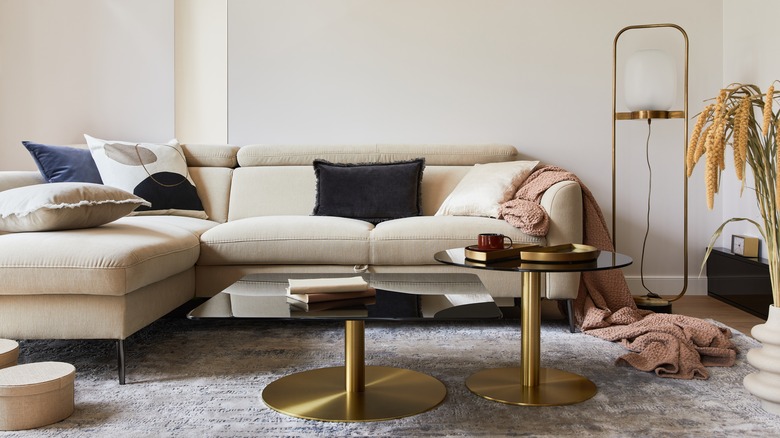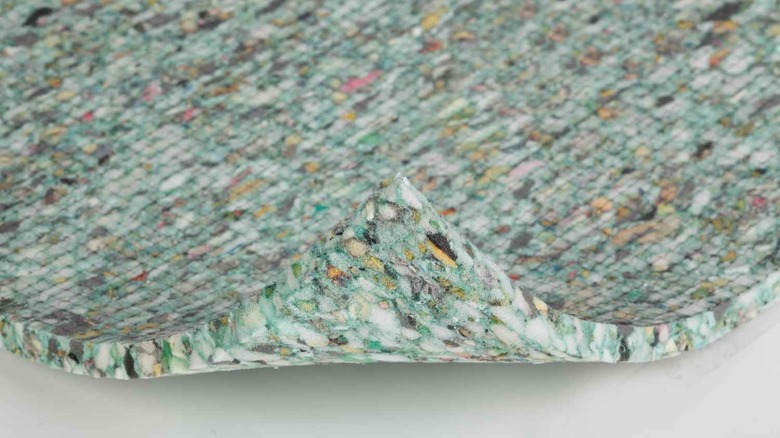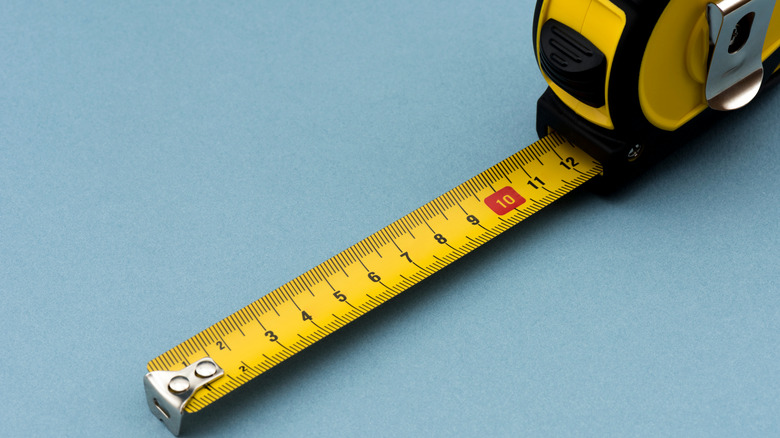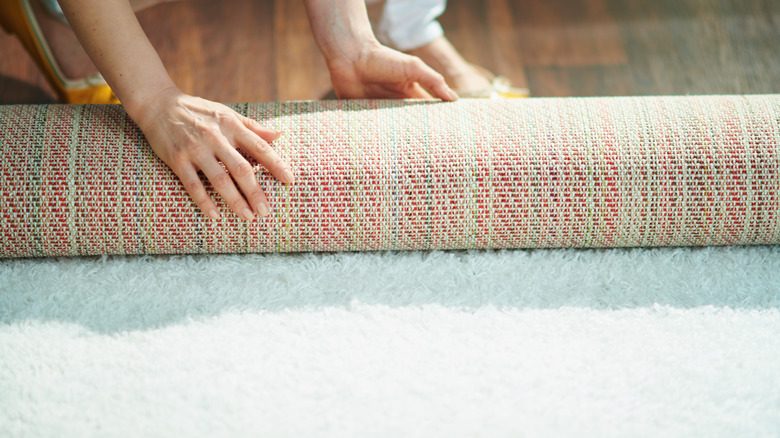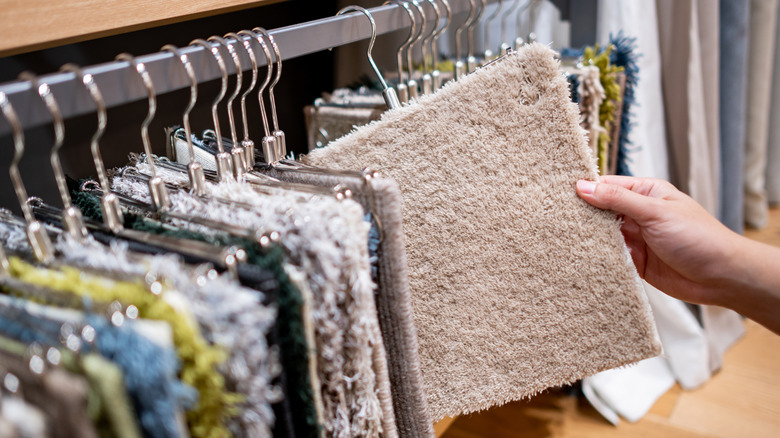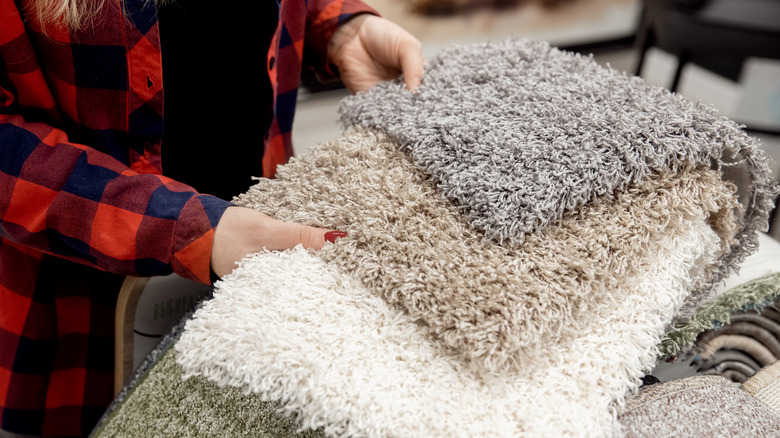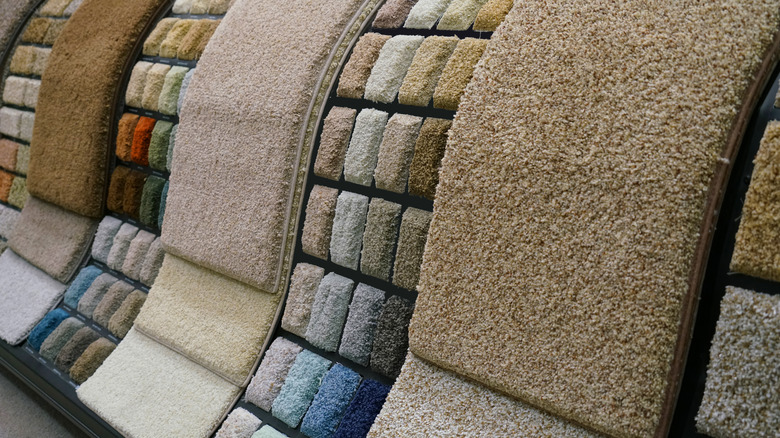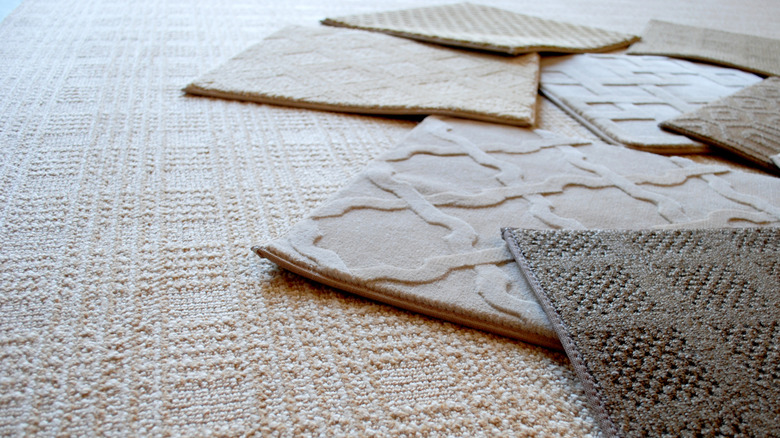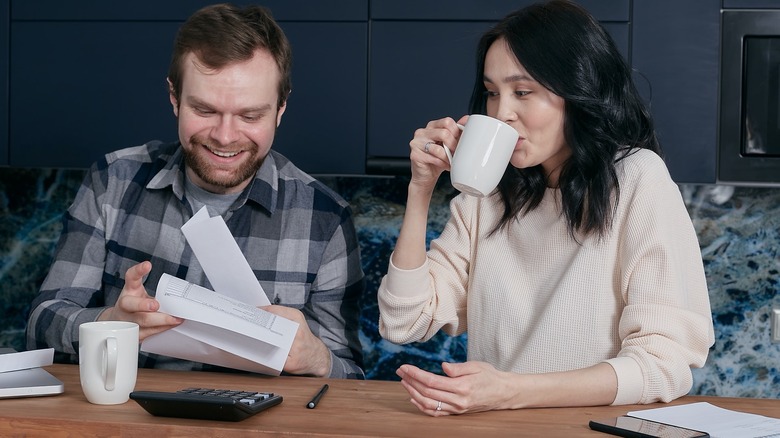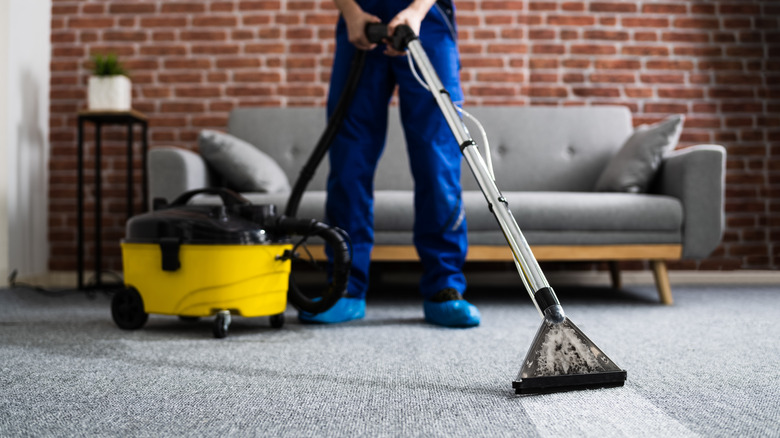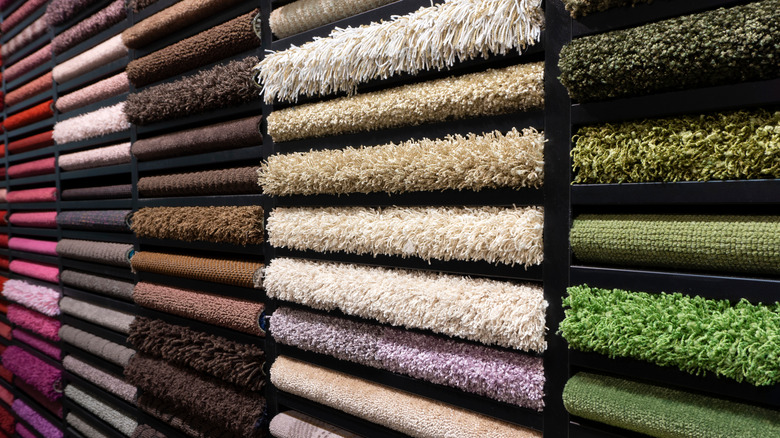Mistakes Everyone Makes When Buying Carpet
Buying carpet for your home is a pretty big deal. Not only does it play a significant role in your environment's feel and appearance, but it's not a cheap purchase either. It's a real investment, and it's something you should feel good about. With so many carpet options out there, we understand that finding the right one may feel a bit overwhelming, which in turn may cause you to rush through the process and potentially make some mistakes.
As The Spruce helps point out, there are some main things to look out for when shopping for carpet, such as being knowledgeable on everything from fiber types and face weight, to understanding warranties and what to look for when comparing quotes. We know it may seem daunting, but with some patience (and a few deep breaths), you'll see how the extra effort is truly worth it. Avoid any carpet-buying blunders by familiarizing yourself with these common mistakes.
Not using an underpad
Many opt out of purchasing an underpad since it's hidden beneath the carpet. It's easy to ask yourself, why spend extra money on something that isn't even visible, especially when the carpet and installation already cost so much money? While we can understand how people jump to this conclusion, the fact of the matter is not buying an underpad is a huge mistake.
According to Home Depot, an underpad has many benefits, including preventing the carpet from bending and wrinkling, absorbing the impact of footsteps (and thus limiting wear and tear and acting as soundproofing), and it also simply makes the carpet more comfortable to walk on. As an added bonus, an underpad works as insulation, saving you money when it comes to heating and cooling bills. You may pay a little more money upfront, but you'll save in the long run. Even though the underpad itself may not be visible, it certainly has a positive effect on the look and feel of your carpet.
Taking incorrect measurements
You'd think that taking measurements of a room for carpet would be easy enough, but it turns out that's not really the case. Figuring out the accurate calculations requires more than simply getting the room's square footage, as many other factors come into play. Don't believe us? Check out The Spruce's guide to measuring for carpet. As you'll be able to see, additional specifications must be accounted for. For example, you have to measure into the middle of a doorway, which adds anywhere from two to six inches to the total room dimension. Then there is the width of the roll of the carpet, which doesn't always clearly correspond with the room's dimensions.
Hey, we're not saying that it's impossible to make the correct calculations, but only that it's quite complex. To avoid running into issues, we recommend passing this task over to the professionals who will ensure you get exactly what you need.
Forgoing professional installation
Here's another example of something that may seem easy enough, but in reality, really isn't. Even if you'd consider yourself a handy person, you should pass on trying to install your carpet yourself unless you're an actual carpet professional. Of course, you'll have to pay for it, but isn't it better to pay a little more upfront than have to dish out more money to fix it or reinstall it later?
Lewis Floor & Home advises carpet buyers not to think of carpet installation as just another home DIY project. First, you would need the proper tools (which include a power stretcher, seaming iron, tackless strip, carpet spreader, and many, many more) — and then you actually need to know how to use them! Additionally, the publication pinpoints various details and scenarios you'll likely encounter, such as specifics about the subfloor, the seaming diagram, and not stretching the carpet enough or properly. Unless you're a professional, take a pass on this DIY project.
Not taking lifestyle into account
It's important to be realistic when shopping for carpet, and as Lizzo says, the truth can hurt. For example, if you have animals or kids, you should probably choose a different carpet than someone with a more mellow lifestyle who barely has any dirt or foot traffic in their house. According to The Family Handyman, there are a few factors to take into account when deciding what carpet is right for your home.
For example, carpet style Saxony is appropriate for more formal spaces where there is less foot traffic because it tends to show footprints and even vacuum marks, whereas a Frieze style carpet is extremely durable and can last for 20 years or more. Then there is Looped or Berber, which is known for its elegant appearance but is also much more challenging to clean and repair. Carpet fiber types are another main thing to consider, which we'll dive into next.
Not knowing the different carpet fibers
While not the most exciting thing to talk about, knowing your carpet fibers is incredibly important. The fiber determines everything from the carpet's durability to how it responds to stains. With the help of Floors USA, let's briefly cover some of the main types.
Nylon, the most popular carpet fiber, is the strongest of the carpet fibers and is very resistant to wear and tear, stains, and even molding, mildew, and insects. It maintains its height well too. Acrylic is considered a manufactured wool because it has a similar look and feel to the natural material, but for a way cheaper cost. Though it does well with mildew and staining, it's not super durable and, therefore not great for high traffic areas. Olefin is the most popular fiber after nylon. It has many similar qualities to nylon and is actually less expensive, but it does not hold its height as well and is prone to matting. Polyester feels luxurious and is easy to clean, but does not do well under foot traffic. Blends, which are typically made from a combination of nylon and olefin, are durable but do not do well with staining. Lastly, there is wool, a natural fiber. Wool is strong, good with stains, maintains its height, and feels luxurious too. While all that may sound (and feel) amazing, wool must be properly maintained and can only handle certain cleaning chemicals. It can also attract insects if it goes unattended.
Worrying too much about weight
Many people think that the higher the face weight of the carpet, the better it is — but that just isn't true! Other factors such as fiber type, fiber twist, density, and overall style play a more significant role in carpet quality. But first, to clarify, a carpet's face weight is different from the carpet's total weight. As The Spruce explains, the face weight is the weight of the carpet pile per square yard, and is measured in ounces. It's the weight of only the fibers, not any additional materials used in the carpet's final construction.
Face weight is a common selling point that retailers hinge on. They play on our natural instinct to assume that the heavier the face weight, the better, so you need to understand the lingo so you don't make an uninformed decision. For example, comparing the face weight of two different carpet styles (such as Berber and Saxony) is like comparing apples and oranges — they're two completely different things! You should only compare face weights when looking at two (nearly) identical carpets. If they have the same fiber, style, and twist, then sure, take a look at the face weights, and it's probably best to go with the heavier one.
Not taking home a sample
In the same way you take sample paint swatches home before deciding on a color to cover your walls, you should also take home a carpet sample before having it installed on your floor. Simply choosing a carpet based on a picture in a catalog or online is a massive no-no, because, as House Home & More points out, digital or printed images are often color enhanced and tweaked in a way that may not be accurate to how the carpet actually looks. Further, retailers may attach adjectives like "luxurious" or "premium," which may be misleading — they are just words, after all.
Even if you see a carpet in person at a store, you should still take home a sample before moving forward. Why? Because you need to see how it looks in different lighting and how it matches your furniture, fixtures, and wall color. The environment of a store is so different from your home, so don't cut corners on this one.
Falling for promotions
We all love a good deal, but don't fall for the trick of a too-good-to-be-true carpet promotion. Whether they promise you an insanely cheap price for the carpet itself or for the installation, chances are you'll encounter some financial surprises down the line that you won't be as excited about.
One user on Reddit shared their experience with a home improvement store's promotion they jumped on. After feeling good about the initial promotion quote, they moved forward with the next step of getting their room measured, after which point the final quote ended up having a nearly 50% price increase. And the saga only continued from there. Colonial Carpet & Flooring explains the initial quote can change depending on the condition of your subflooring, your room's shape, and what kind of padding you choose. So if you get a surprisingly affordable quote, understand that it probably is just a starting quote that doesn't take these factors into account yet.
Not asking the right questions
Along with researching customer reviews, you should also know the right questions to ask to ensure you find the best carpet retailer for you. Wondering what those questions should be? Let us help you get started. Regarding the quote, Style Flooring advises you to ask whether it's non-binding and if it'll change or have the potential to change down the road. Another main question to ask is if the quote includes the cost of all materials and labor.
Too often, people purchase carpet thinking they've paid for everything, only to find fees for installation or whatever else tacked on later. Be sure to also ask about the warranty, the carpet's maintenance, and anything else you're curious about. Don't feel uncomfortable or talk yourself out of asking questions — you're the one purchasing the carpet and making this significant decision for your home, and it's your right to know.
Disregarding the warranty
Many carpets will come with a warranty of some sort, usually with the option to add on more coverage for a fee. When buying a carpet, it's easy to brush off this part of the process, only focusing on choosing the carpet you like and getting it installed. Though it can be grueling to think ahead to what your carpet may be like after a year or two of living with it, it's important to understand your warranty, ask questions, and even shop around for a better one.
If you're unfamiliar with the types of carpet warranties, Floor Factors breaks down some of the most common ones. A quality assurance warranty, or wear warranty, is going to provide minimum protection. This is the one typically already included with your purchase. It will cover major issues, such as your carpet coming unattached from the floor or pieces literally falling apart. It will not cover wear and tear, such as matting or flattening, or pretty much anything that isn't an indication of some sort of malfunction. Then there is an appearance retention warranty, which relates to the original appearance and texture of the carpet (think fraying, untwisted pile fibers). Other popular options include stain and fade warranties, which are self-explanatory. And yet, even if you go with a warrant that covers stains, read the fine print of the conditions because you know things aren't always as good as they seem.
Not comparing quotes
So you've found a carpet you like — congrats! But before you start signing papers and scheduling your installation, take some time to compare quotes from different retailers. Consumers' Checkbook points out that sometimes comparing prices is tricky because it can be hard to find the exact same carpet style at two different stores. Also, many large retailers change style names from the names given by the manufacturers, making things even more difficult to track. It's not impossible though, and with a bit of patience, you could save a lot of money.
When comparing quotes, Carpet Professor points to five main carpet specifications you should prioritize looking at: fiber type, pile height, tuft-twist rating, pile density rating, and pile face weight. By knowing these specs, even if you don't find the exact carpet at a different store, you'll be able to at least compare the qualities of each. Don't get discouraged and don't be afraid to ask questions!
Assuming expensive means better
In the same way you shouldn't just assume that a heavier face weight carpet is better than a lighter one, you shouldn't think that just because a carpet is more expensive than it's automatically better quality. Retailers are notorious for jacking up prices, especially if they can alter the names and tack on words like "premium." People fall for marketing tactics like these all the time, and who could blame them? Let's just make sure you don't make the same mistake.
Home furnishing store Millers of Montrose compares cheaper to more expensive carpets across five categories to allow you to understand what you're really getting by spending more (or less) money. Sure, in many cases you pay for what you get, and it's not wildly uncommon for a more expensive option to be better, but what's important is that you know what your money is getting you. If two carpets have the exact same qualifications, then there's no point in paying for the one with the higher price.
Thinking stain-free means it'll never look dirty
One of the biggest worries of having carpet in your home — especially new carpet — is getting stains. We all have those friends or family members prone to spilling, so we don't blame you for holding your breath every time they hang out on the carpet with a glass of wine in hand. Because of this, the idea of a "stain-free" carpet sounds pretty appealing, but before you think you've found the miracle carpet of your dreams, let's get real about it.
HowStuffWorks explains that carpets labeled stain-free or stain-resistant are coated with a chemical that acts as a barrier between the spill and the carpet fibers. The coating certainly can make cleaning up messes easier, but that's the thing: You still have to clean and maintain your carpet. Plus, these types of carpets are not invincible. Eventually, stains will show. It's unavoidable. Another disappointing truth is that the coatings used on these carpets are typically toxic. According to Saddleback Carpet & Flooring, 98% of synthetic carpeting contains an ingredient that takes over a century to biodegrade. Yikes.
Choosing a carpet based solely on appearance
A word to the wise: Don't pick your carpet based on appearance alone. We all like pretty things, but buying carpet is a considerable investment, and the look of a carpet may not be enough to warrant a purchase. You should ask yourself many questions before making the big decision, and they go beyond just aesthetics. HGTV points to some key things to consider when making a carpet selection, beginning with what room you'll be putting the carpet in.
Does the room get heavy foot traffic? Does it have direct access to the outside? There are also color and style aspects to take into consideration. For example, you can make a smaller room appear larger by using a lighter-colored carpet. Or, the fact that you should choose a lighter-colored carpet for rooms that don't get a lot of natural light. Then, of course, cost. Don't worry, though. There are a ton of carpets out there, and we have no doubt you'll find one that you like the appearance of and is right for your home.
